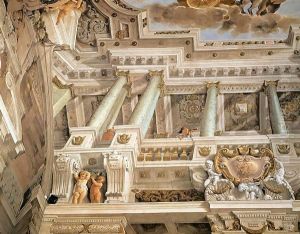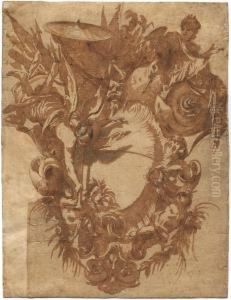Agostino Mitelli Paintings
Agostino Mitelli was an Italian painter of the Baroque period, renowned for his skill in fresco and quadratura—a form of illusionistic ceiling painting. Born in August 1609 in Battidizzo near Bologna, he was part of a family with artistic ties; his father, in fact, was a decorative painter. Mitelli initially trained under his father, Giuseppe Mitelli, but would later become a prominent pupil of the esteemed quadraturista Giovanni Maria Galli, known as Bibiena.
Under the guidance of Bibiena, Mitelli's skills flourished. He became an adept painter of architectural perspectives, creating elaborate illusionistic spaces that extended real architecture into the realm of the painted surface. Mitelli's works often depicted deep recession through porticos and colonnades, leading the eye into imagined, distant vanishing points.
Mitelli worked extensively with another artist, Giacomo Colonna, who was known for his ability to paint figures that perfectly complemented Mitelli's architectural illusions. Together, they created many significant works in Bologna, as well as in other Italian cities. One of the high points of his career was his work in the Palazzo Ducale in Sassuolo, where his frescoes display an extraordinary virtuosity of perspective and architectural fantasy.
Mitelli's work was widely influential, and he played a significant role in the development of Baroque decorative frescoes. He travelled outside of Italy as well, working at the court of King Philip IV in Spain, which was a testament to his international reputation.
Agostino Mitelli died in Madrid in 1660. His legacy lived on through his many students, including his son Giuseppe Maria Mitelli, who became an accomplished artist in his own right. Mitelli's style and techniques would influence the development of Baroque ceiling decoration throughout Italy and beyond, contributing significantly to the visual vocabulary of the period.

